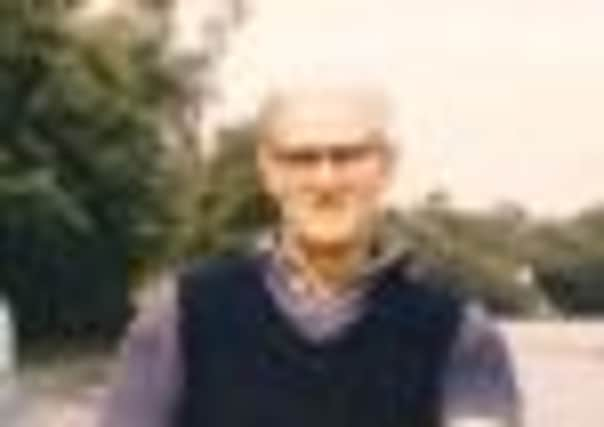Obituary: Rev Grahame (Raymond) Bailey, minister


Raymond Bailey claimed that among the main influences on his life were the Student Christian Movement (SCM) and the Iona Community. He joined both organisations as a student at Edinburgh University during the 1930s and met his future wife, Mary, in the SCM. Inspired by the founder of the Iona Community, George MacLeod, he helped with the rebuilding at Iona Abbey in the summer of 1939 under the tutelage of professional craftsmen. This was a formative experience because of the friendships he formed with these men, and because of the practical skills he learned, such as joinery, which he enjoyed using for the rest of his life.
Raymond had an unusually varied and interesting ministry, taking him from the villages of the Punjab to the “dreaming spires of Oxford”, from a church extension charge in Edinburgh to a rural parish in the Borders, and concluding in Pont Street, London.
Advertisement
Hide AdAdvertisement
Hide AdThroughout his career, he was held in respect by the people he served and won their affection with his charm, wit and modesty. He followed in his father’s footsteps by working as a missionary in India during the Second World War, where his fluency in Urdu enabled him to communicate with the Punjabi Christians.
In Oxford (1947-57), he was appointed as the minister of St Columba’s Church and also the Presbyterian chaplain to the university. Students from Scottish and Presbyterian backgrounds were attracted to the church by the clarity of his preaching and his progressive approach to social and political issues. Many of them later became leaders themselves in a variety of public service professions and to this day they talk of the powerful influence that Raymond had on them.
Through his sermons he provided them with principles by which to live and a practical example of those principles in his own life. Moreover, he and Mary offered pastoral care – and also afternoon tea – at the manse every Sunday during term time.
Many came to regard this as a “home away from home”. Raymond acknowledged that his wife was a source of imaginative inspiration behind almost everything he achieved and their “joint ministry” was most in evidence in his second major charge, a church extension parish in Edinburgh (1957-1967).
At St Martin’s, Niddrie, he established a new church in a totally different setting from Oxford. Once again he and Mary worked tirelessly to develop a Christian fellowship within the congregation and to serve the wider community.
The church was a hive of activity, with a large Sunday school, a lively youth club and a vibrant women’s guild. The worship was dignified but also innovative, with Mary playing the organ, and Christian festivals celebrated with musical and decorative panache.
Both in Oxford and in Edinburgh, Raymond took part in ecumenical activities, and when working in the Punjab, he was sensitive to the other major faiths of Hinduism and Islam.
By the time he returned to Pakistan in 1967 for a further spell, it had become a Muslim country; and so he endeavoured to build bridges between the Christians and their Muslim neighbours.
Advertisement
Hide AdAdvertisement
Hide AdHis final job in Scotland (1971-77) was in the Borders, where he was minister of the rural parishes of Ladykirk and Whitsome. This was his first experience of country life, but once more he engaged with the concerns of local people and was proud to be the guardian of a beautiful and ancient church, dating back to 1500.
Raymond was an exuberant character: volatile, fiercely honest, curious, funny, warm-hearted and affectionate. His sometimes stern exterior belied a mischievous sense of humour, and his exceptionally enquiring mind was applied not only to his search for theological understanding, but also his wide-ranging interests and hobbies.
Above all, he was interested in people: all people of whatever age, class or race, from dukes to dustmen, from Pakistani villagers to the intellectual elite of Scottish society.
He maintained long-lasting friendships, and throughout their marriage Raymond and Mary were very hospitable.
However, Raymond’s compassion was expressed not only through his relationships, but also the causes of social justice he espoused – most famously the successful campaign to allow women to join the ministry of the Church of Scotland, for which many female ministers still feel deep gratitude.
Less well known was his strong support for the abolition of the death penalty. He had a lifelong involvement with the Leprosy Mission (founded by his grandfather) and eventually became its honorary president in Scotland. In his retirement, he was also an active member of the Labour Party and a dedicated collector for Christian Aid.
At the heart of Raymond’s life was his family. He followed the fortunes of his four children, Alan, Diana, Elizabeth and Rosalind, with great interest, always ready to encourage and support.
And after Mary became ill towards the end of his career he looked after her for two decades with exemplary patience and devotion.
He felt keenly the death of his only son in 1992, but took delight in his eight grandchildren and six great-grandchildren, acting as the loving patriarch of an expanding clan.